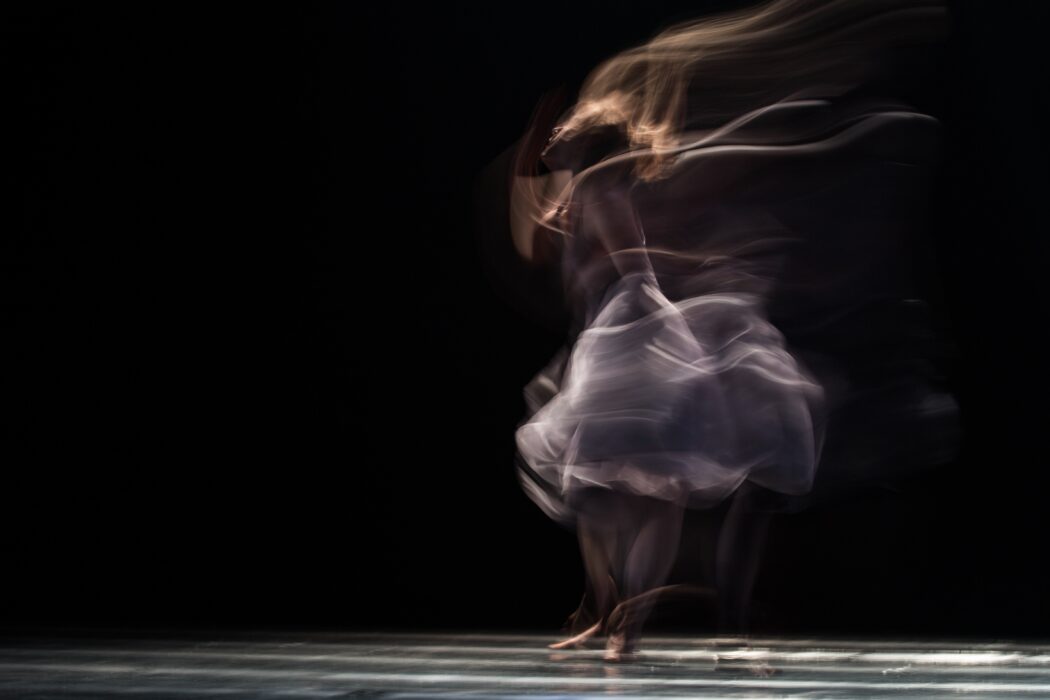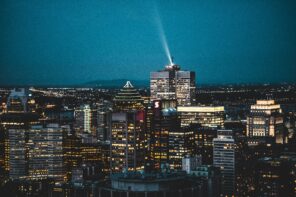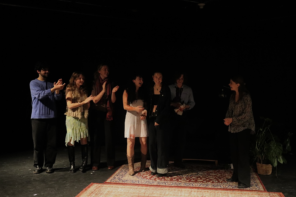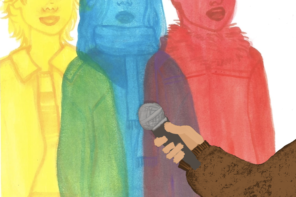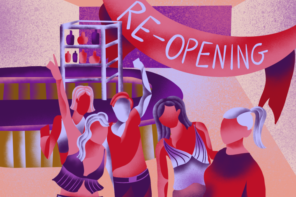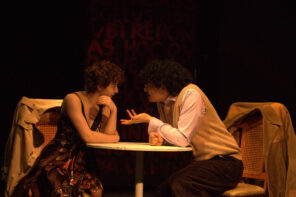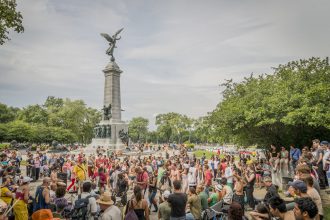The intersection of dance and modern art at choreographer Sasha Kleinplatz’s “We Move Together or Not at All” and “Miracle’ing/Close to Me/Close to You” provides a space for creative expression that is unlike anything I’ve seen before. Kleinplatz’s two intriguing performances offered me a new perspective on modern performative art. “We Move Together or Not at All” involves an improvisatory performance by a single performer engaging in interpretive dance inside a miniature greenhouse. “Miracle’ing/Close to Me/Close to You” is a more abstract group production that comments on the nature of performance and practice. I had the pleasure of sitting down with Sasha to discuss her background, the performances, and her perspectives on life and art. Here are some of my favorite parts of the discussion.
***
Tell me a little bit about your upbringing and how you got interested in dance and choreography.
I grew up in Windsor, Ontario, which is right near Detroit. I started liking dance when I was really little, like three or four. I saw “The Nutcracker” or “Swan Lake” and I was rally into it, but I didn’t start taking class[es] until I was ten. Also, when I was around ten, I saw Alvin Ailey, which is a modern dance company from the U.S., and that was really inspiring. I was kind of influenced a lot by being part of the indie rock scene and the rave scene in the nineties, so both of those communities and aesthetics were important to me in the way I thought about performance.
How did you end up in Montreal from there?
My two best friends moved [to Montreal], and I followed them. I just wanted a change, and they both came here and they said they loved it, so I moved here too.
Do you have a favorite place where you’ve put on a performance before? Is Montreal your favorite place to perform/work?
I think what’s pretty unique about Montreal is that rents are pretty low. They’re going up, but they’ve been incredibly low compared to any cosmopolitan city in North America. I think what that allows is for people to have more time to work on their art and less time having to have nine-to-five jobs, so it’s really unique in that way. In terms of a place to create work, I think it’s the best place in Canada to be a choreographer or artist.
Do you see any influence from Montreal in the performances you’ve put on?
Less so – I think what I’m influenced by is the way you can access unusual spaces here. I put on a show in an empty indoor pool that we were able to get from the city for free, so just stuff like that, unique locations. I put on a festival for the last two summers that was made for parking garages and alleyways and backyards. I’m more inspired by the openness people have to unusual performance contexts here.
That was one thing that I took away from the second of your two performances – “Miracle’ing.” To me, it was not what I would consider to be a traditional dance performance, but then I started to think about what exactly defines a ‘traditional’ dance performance. You mentioned “The Nutcracker,” and I think that’s what I always saw as ‘traditional’ dance – how do you go about the planning process for a show like “Miracle’ing”?
That project started out looking at people’s history with dance and their history with dance training, so how they had trained from the time they were little kids and what they remembered. We go through these very intense training periods as dancers, so the central idea started off as how we remember training and how training has marked us, and then sort of building out from there.
You could really tell that each of the individual performers had a unique experience with the training. Each of them brought their own flair to the performance. Is there a direction technique you use with the performers to help them unlock that aspect of themselves when they’re performing?
Yeah, I mean we talk a lot about individual desire, so how can they follow their own interests and desires while performing, and this idea that whatever comes to them is ok. And also, how can they mediate between their individual interests and what they feel the interests of the group as a whole are, and how can they move between those two things.
When you say “the group,” are you referring to the performing group, or the audience and the performers as a whole?
We only talked about them as a performing group, but we have talked a lot about what does it mean to be watched, and how do they want to respond to being watched, and how to be present to an audience. One of the things I’m focused on is how do we stay in a practice mindset – the looseness of practicing versus the formality of performance and dance. It’s funny because I don’t know a lot about sports, but I’m really influenced by this idea of practicing, and how loose and dynamic it is, and sort of trying to maintain that rather than switching to a performance mindset.
In “Miracle’ing” there was a lot of subtle and some not-so-subtle humor. Do you think that helps loosen the bounds of the formality of performance, and do you think it makes the performers more comfortable in that improvisation?
I don’t know if it makes them more comfortable. They have oftentimes told me that they’re not comfortable, but they move between comfort and discomfort. I do think the permission to be silly is helpful, and another thing that I’m interested in is improvisatory comedy, and when people break. There’s something so human about it, so breaking is a very welcome part of the process, and it doesn’t have to be hidden. I think it allows the audience a different kind of window into the work.
How does the improvisation differ between “We Move Together or Not at All” and “Miracle’ing” and is there a substantial choreography difference between coordinating the improvisation for an individual versus a group?
Yeah, it’s somewhat different. For [We Move Together or Not at All], what we talked a lot about, is that each of the dancers has a solo practice that they do, and it’s part of what they do on a regular basis. So how can you translate your solo work and your solo research into this other being, this plant being? In the group piece, we really didn’t talk about ‘soloness’ at all; we talked about ‘individualness,’ but that feels different from ‘soloness’ to me.
You definitely seem to have a lot of musical influences in these performances. I know you talked about the indie rock and rave scenes. Is music one of the first things that comes to mind when planning a performance? I was really intrigued by the silent parts of the performance as well, and I don’t think I’ve ever seen a dance performance with no diegetic sound. How close to your thought process is music (and lack thereof) when developing these ideas?
It’s really close. Usually what happens first is some kind of conceptual idea, so in the case of “Miracle’ing” the conceptual idea was virtuosity and training, but then immediately the second thing that happened was that I made a playlist, so I asked the dancers to contribute to the playlist, and in that particular case, we were working with music that was love songs or melodramatic songs. There’s always a playlist for each piece I make – I made a piece with seven men, and all of the music was original and live, but we made hip-hop playlists to work with in rehearsal. Because the dance was very physical and intense on their bodies, we wanted something with a heavy bass beat that would support what they were doing. For me, there’s always a concept and a playlist that follows very quickly after.
Would you say there’s been a (musical) genre or artist that’s been a big influence on the work you create?
Sometimes it’s pop music, and sometimes it’s R&B, and sometimes it’s hip-hop. I would love to make a dance piece to one album, but I’ve never tried to do it. I think it would be really fun.
Have the messages in your performance changed a lot over time, or do you have a few consistent inspirations that you’ve used throughout your career?
I think it remains pretty consistent. A lot of what I think about in making art is how you create these temporary worlds. Whether it was the piece with the seven men which was about my grandfather and his relationship to faith and prayer, or the twelve-person piece which is about our relationship to childhood training. It’s about these temporary worlds and trying to create a sensitivity for the audience to these temporary worlds, and maybe a little bit about how we can be more sensitive to each other. I don’t mean sensitive like “we should all be nice to each other,” but more like how we can be more sensitive to each other, and more vulnerable and present with one another.
If that’s been a consistent theme throughout your career and life, do you think the pandemic changed the way you see that issue, or do you think it changed the way people interact with their own vulnerability, and have you seen a shift in the performances you’ve put on in the Covid era?
I think the shift I’ve noticed is feeling more careful, but I think that’s positive. Some people are like, “I don’t want to be more careful,” but being more careful is wonderful. Using more care, taking more care, being more attentive – that can never be bad. I know for some people they think that makes them less free, but I think care can only make you more free.
One thing that I’m always curious about with artists is if they have advice for younger people on how to pursue their artistic goals? There’s such an emphasis today on taking the so-called “safe path” in life. Do you have anything you would say to people who are struggling to pick a path in life?
I can tell you what I think, but what I think is not the happiest thing. It’s not unhappy, it’s just maybe more practical than (how) people want to think. I knew two people, one of whom worked in a doctor’s office or a physiotherapist’s office, and another who worked in a hospital as an administrator, and they’re two of the most exciting Canadian artists I know. They spent years working nine-to-five jobs, and they worked on their art during nights and the weekends – and they were financially stable. They didn’t have to go into debt to work on their art. I think people sometimes think that in order to do art, they have to give everything up and live this precarious life, and what I realized from these people – Dana Michel and Bridget Moser – is that they didn’t have to put themselves in a financially precarious position, to my knowledge. And Bridget particularly has talked very openly about that choice she made, and how it made her life stable in a way that actually allowed her to make better art in some ways.
***
Sasha’s last response especially resonated with me. I have been pursuing film, music, and writing for years now. However, I’m also approaching a point in my life where I must make some crucial career-defining decisions. While I enjoy business school, and I have a strong passion for marketing and operations management, my two fields of study, I frequently worry that I won’t be able to pursue my artistic goals when I enter the workforce. I absolutely agree with Sasha’s point that one can work and be an artist concurrently. Going into the world of business shouldn’t mean that I have to give up on journalism and music, and hopefully, I won’t.
Usually, I prefer to write analytically and in the third person, but this topic is deeply important for each and every one of us to consider. I’m going to include a piece of personal advice: as cliche as this may sound, we only get one chance here on Earth, and you’re selling yourself short if you don’t make some effort to pursue your artistic dreams, or any other dreams for that matter. Like Sasha touched on, working a nine-to-five job and pursuing one’s passions are not mutually exclusive. They only are if you let them be. I am incredibly lucky to even have the opportunity to pursue my passion for art in the first place. If I don’t do whatever I can to fulfill this opportunity, will I truly be able to look back and be satisfied?

